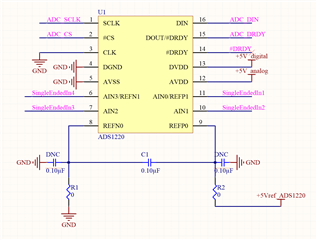Other Parts Discussed in Thread: OPA2197,
Hi TI Technical Support Team,
I am planning to use TI ADS1220 24 bit ADC in single ended mode. I will measure two inputs, one will vary between 0.5V and 4.5V and the other input will vary between 1.5V and 3.5V. AVDD of ADS1220 is provided from 5V LM7805 (AVSS=GND) and DVDD is provided from another LM7805 IC (DGND = GND). 5V reference to REFP0 pin comes from ADR5045 5V reference (buffered with OPA2197). I attached my schematic. I am a bit confused regarding the datasheet, so I decided to ask the following questions to make things clear and just to be sure. I am sorry if these questions are asked before.
1. As my voltages are beyond 2.048V internal reference, I have to use external 5V reference. Is this true or although the reference is 2.048 I can measure for example 4.5V?
2. My inputs are connected to AIN0 and AIN2. Is it better to connect AIN1 and AIN3 to GND, and make differential measurements between AIN0&AIN1 and AIN2&AIN3 than single ended measurement? Which one can give better performance in general, single ended or differential?
3. Datasheet states that single ended measurements can be made by connecting AINN to AVSS externally or by connecting them to AVSS through software (through MUX). AINN are AIN3 and AIN1 (?), Then actually in total, I can measure two analog voltages in single ended mode, right (because the others are connected to AVSS and cannot be used)?
Thank you for your help,
Regards,
Ahmet


